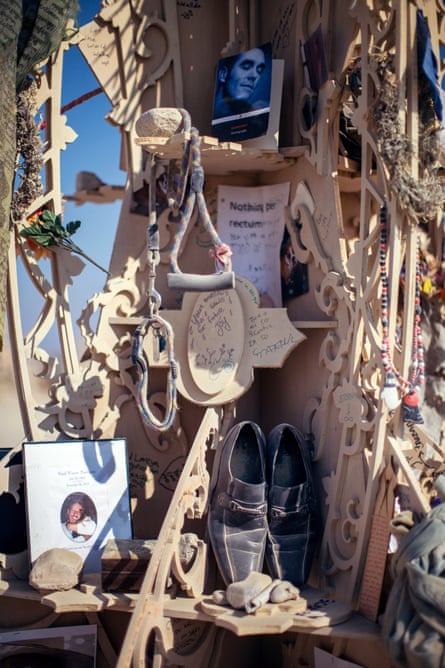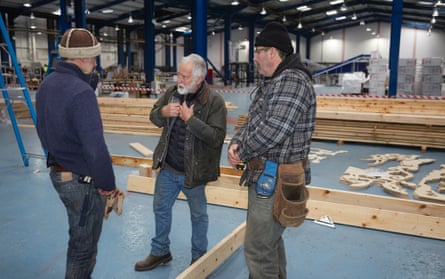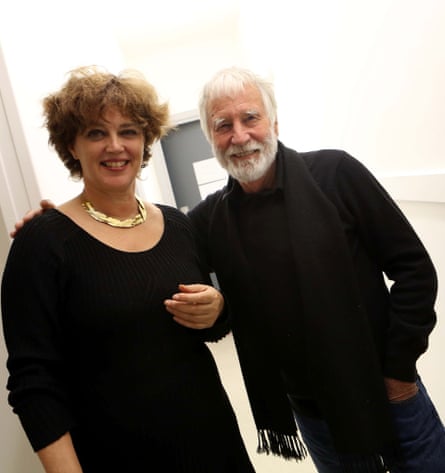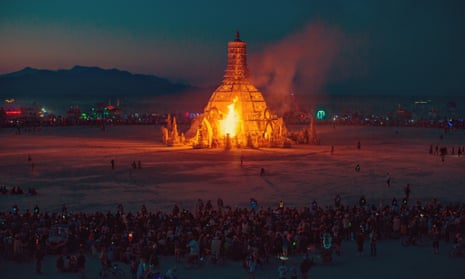Northern California is bracing itself for the biggest storm in years as I drive north from San Francisco to David Best’s house near Petaluma. The sky is sagging, the light fading and, as the road narrows, climbs and twists through lush countryside, it seems like I am heading to a remote farmhouse in Shropshire. Then the fog rolls in.
Best is standing in the door of the house as I pull up. He has a full head of hair, white as a sheep’s. He’ll be 70 this year. “I just made tea,” he calls out, confirming the impression that I might be visiting an esteemed British playwright or an actor – preparing for the role of a rancher perhaps – in rural Britain.
The house is spacious, airy and modern but, with a log fire blazing, it’s cosy too. There’s interesting stuff everywhere. A bright game wheel from a gambling town – Atlantic City, somewhere like that – looks like a Rauschenberg. Art is on all the walls – and there is plenty of wall. Best knew he wanted to make art from the age of six when his stepfather, an artist, entered his life. He went on to study at the San Francisco Art Institute (Jerry Garcia was there too, a few years ahead of him) as the city underwent a cultural shift from beat (“I had my first espresso when I was 15”) to hippy. Some of the stuff on display is Best’s – drawings and paintings spanning many decades, a sculpted animal that is actually a tea cosy – but the work that marks him out as a uniquely important artist doesn’t lend itself to being shown in either a home or gallery. There’s a simple reason for this: it no longer exists – except in photographs and in the collective memory of those who have… what? Seen it? Experienced it? Been part of its creation?

Before we settle down to talk about these issues he shows me around the outside of the house in the dim, distinctly unCalifornian light. Outbuildings, the hulks of old cars and other bits and pieces of machinery give it the hillbilly feel of rural Kentucky. In a converted barn, there is an incredible thing that might just about be described as a car. It’s a sleek, black one-seater, built out of the fuel tank from the wing of a jet. This is his new passion. Later this year he’ll be driving it on the Bonneville salt flats at upwards of 180mph. It looks as it does – long and dangerous as a rocket – purely in the interest of velocity but the art cars he makes are marked by an extravagant refusal of function. There’s a vintage Cadillac parked in the drive, its exterior so encrusted with jewels that it seems like it has been formed at the bottom of the seabed: those are pearls that were its tail fins! He got into stuff like this in the early 1980s, in Houston, right at the beginning of the art-car craze but – in a way that is typical – is careful to emphasise that he was just one of a number of people involved at the time, that the first art car was actually done by Jackie Harris.
Since then, art cars and mutant vehicles have been one of the many jaw-dropping marvels at the Burning Man festival in the Black Rock Desert, Nevada. It was here that Best created his most important works, works that have become part of the architecture of the temporary city of Black Rock almost every year since.
He tells me the story of how this came about when we’re back inside, in front of the fire that seems like a flickering reminder or echo of the annual conflagration of Burning Man.
“I guess I first went to Burning Man in 1997, then did an art car the next year. In 2000, I had this material from a toy factory. I thought I’d make something for the festival out of it. At the time I was working with a young kid called Michael Hefflin. He was building a three-wheel motorcycle for the festival but before the festival he was killed doing 140mph on a motorbike. He was 27, 28 – maybe younger. His friends all said he’d still want us to go. These kids had never experienced death before. So we went, we built this thing and it became obvious that we were building a tribute to Michael. And as we were making it 100 people came by and added the names of people they’d lost. Then we put some diesel on it and burned it. Either Thursday or Friday night, I can’t remember. No ceremony.”
I was at Burning Man in 2000 but with so much other stuff to do I didn’t see this ad hoc tribute being built or burned. The following year, though, Best built something so beautiful and great it was unmissable.
“In 2001 they asked me to come back and build a temple. In the evolution of Burning Man, Black Rock had become a city. We had a medical centre, a cafe, porta-potties, we had places where people could celebrate but we didn’t have a place to meditate. There was a communal need. I thought, ‘What would I dedicate a temple to?’ Not having any religion – and not being very fond of religion – I thought how in some faiths you can’t be buried in a cemetery if you’ve committed suicide. So since Burning Man welcomes so many things, the most sacred place, in the centre of the temple, should be in honour of those who’ve lost someone to suicide. By the end of the week 500 people had put names in the centre and 10,000 had put names elsewhere in the temple, the names of people they’d lost.”

Their names were written on little blocks of wood in a gigantic, Balinese-style temple made out of off cuts from a factory. People also added other decorative tributes of their own. Work on building the temple started before the gates opened but anyone could participate in its construction as it gradually achieved its final form in the course of the week-long festival. The festival’s theme in 2001 was the Seven Ages, derived from the famous speech in As You Like It. Evidence of Shakespeare was all around but among the cloud-capped towers and gorgeous palaces, Best’s anything-but-solemn Temple was a thing of wonder. Framed by the desert sky it was airy, ornate, delicate. At dawn it seemed stark and ghostly, or skeletal as it emerged from one of the dust storms that engulfed the temporary city that year. Its power was immense. All around was the sound of music, the wild hedonism and carnality for which Burning Man is famous. There were no signs in the temple saying what you could or could not do, but inside there was an atmosphere of intense silence and contemplation. It was still standing, isolated and splendid, after the frenzy of the Man’s burning on Saturday night. Then, on the Sunday evening, the Temple of Tears was consumed with flames.
Since then, there has always been a temple at Burning Man, usually designed by Best (“I’ve done eight or nine”), a task that occupies six to eight months of his year. Some are more beautiful than others, the particular design depending, to a large extent, on what materials happen to be available. Does he have a favourite?
“I think Juno in 2012 was a good one. It had a courtyard. A way of keeping the sound trucks out. Until then, I’d never really taken on a theme, never tied what I was doing to the larger theme of the festival. Juno was the goddess who protected women and at that time in the US women’s rights were under attack and I felt I had to address that.”
What do you think makes a temple? I ask.
“I know what makes a temple. The crew has to be sacred. The people you work with have to be honoured. And if they’re sacred they’ll build a sacred structure. It doesn’t matter what the temple looks like, it’s the intent. With Juno I had two parents working on it whose daughters had fallen off the same cliff . One time, during a meeting with the crew, I was speaking to this guy, he was there with his son. They both had mohawks. He said, ‘I’ve tried to kill myself three times and my wife, his mother, OD’d.’ What it takes to make a temple is humility.”

That applies to you as well, presumably?
“Yes. I’ve battled with that. You know, I’m not a star in the art world like Ed Ruscha or one of those guys and yet people think I’m someone special. I have to keep that in check.”
You say the crew has to be sacred. What does that mean to you, the idea of the sacred?
“I’m not sure I can answer that,” he says. “That it’s protected from all those things people do wrong? It’s hard to make a space that manages that.”
Let’s think about it another way. What’s the difference between a memorial and a temple? Again, he hesitates, says he can only answer in “a round-the-barn way”.
“A memorial is a permanent place where things stay. When I ask someone to forgive a brutal rape and that person puts the rapist’s name in the temple I can promise them that it won’t come back – unless they bring it back. I can promise them protection.”
And your way of protecting…
“…is to burn it. To ensure that that pain and violation go away. One year someone had put a long piece of paper in the temple. It was a suicide note from the Vietnam era. It started, ‘I have a gun under the bed…’ And at the bottom there was an index card saying, ‘Hector finally took the gun out from under the bed and killed himself.’ Now at Burning Man, as you know, nothing is for sale. It’s a gift economy and that note was a gift. It wasn’t a lovely gift but it was a gift. Not all gifts are pretty. That person trusted us enough to share the most painful thing in their life, trusted that it wasn’t going to be ridiculed or sold. Now you back up 200 years to a village in West Africa where a woman carved the name of her son who committed suicide on a log-ladder. Two hundred years later, someone goes there, buys it and takes it to Sotheby’s where a collector buys it for 200 grand because it’s a unique suicide ladder. Hector’s suicide note that the person shared with us is never going to be traded or sold as a souvenir. That’s what I mean by sacred.”
We are, it’s fair to say, a million conceptual miles away from the global hypermarket of the mainstream art circuit. That world has had an vested interest in regarding the art of Burning Man with condescension or derision, but consider the kind of concerns that Best’s work addresses, the needs it serves and the feelings it elicits. Then think for a moment – if it merits even that much attention – about what Best’s exact contemporary Paul McCarthy contributed to the Place Vendôme in Paris: a giant inflatable butt plug. Think, still more briefly, of Jeff Koons. Listen to the stuff spouted by gallerists as they offload the season’s new line of luxury visual trophies on clients who can then recount the story of their latest acquisition as though they had bagged a lion in the Serengeti, alone with only a rusty spear to help. Think of the Turbine Hall at Tate Modern and consider how few artists other than Olafur Eliasson and Tacita Dean have contributed anything to justify the stupendous space or the resources at their disposal.

I’m not being pious – Best’s temples are built and burned in the midst of the funnest, most hedonistic, most ridiculous place on Earth – but the more you think about it the more extraordinary it seems that the institutional art world has been not so much slow as self-harming in not engaging Best’s services. It goes without saying that I am far more exercised on this score than Best himself.
“One of the turning points in my life was when my son was 18. They said if he did a one-man show they’d give him a high-school diploma. The next day I was decorating a trailer – an Airstream – for my wife, Maggie. Later in the day someone came by, an important curator from somewhere, and said, ‘Of anybody I know, you should have made it.’ I was so high on my son graduating and making this Airstream for the woman I loved. I was as complete as I could be. I made a real commitment that I’d never try to make it again. That was 14 years ago, when I started building the temples.”
And now commissions from the world beyond Burning Man are coming in. When I visited Best he had on his drawing board the design for a new entrance to the train station at Sacramento (intended to be permanent, obviously!). Next month, he and volunteers from both sides of the religious divide will build and then burn a temple in Derry-Londonderry, in honour of those who died in the Troubles and as a way of moving beyond – without forgetting – what caused their deaths. It could be his most demanding work to date, not because of the aesthetics or technicalities of construction but because of the history it addresses and the future it hopes to help build. It will be a test of whether the healing potential of the temples can extend beyond the temporary utopia that is Burning Man – and of the communities in which it will be built. It will be what they want it to become. Best has no doubt that it will be a success.
In the meantime, I offer the following observation not as a symbol or metaphor, simply as meteorological fact. In the time we are talking, the weather outside changes. Where the big windows had revealed nothing but the dim shape of a few trees and grey fog, now, as the sun sets, they are filled with a blaze and glow of orange light.
Temple by David Best, Derry-Londonderry, 14-21 March 2015;.
Geoff Dyer’s latest book, Another Great Day at Sea, is published in paperback by Canongate, £8.99. To order it for £7.19 click here
Behind the scenes: how the Derry temple project came about

Helen Marriage is director of Artichoke, a London-based creative company that organises large-scale art events around the country. She talks to Kathryn Bromwich
What kind of events does Artichoke organise?
Our first project was The Sultan’s Elephant, which involved closing central London for four days. We also produced Antony Gormley’s piece on the Fourth Plinth, One and Other, and in 2013 we brought the Lumiere festival to Derry/Londonderry, which was UK City of Culture that year, and turned the place into a giant outdoor art gallery. The aim is always to attract the broadest possible audience: people who think they’re not interested in art.
What will the project in Derry involve?
It’s a 72ft-high wooden, intricately carved temple-like construction that you’ll be able to see from anywhere in the city. The workshops to build it started across the city before Christmas, and it took a month to put together on the site. It will be opened to the public on the 14th and will be ceremonially burnt on 21 March, the spring equinox. For that week people can use it in whatever way they want, whether that’s contemplation or meditation or reconciliation. In Burning Man people tie into the woodwork hopes for the future or messages for love for people who have been lost. In a city like Derry it’s obviously complicated because of past history: there are still tensions.
Who are the volunteers?
They are not only from both sides of the political divide in Derry, but also from all over the world. There’s a guy who was originally from Ireland and had a Catholic girlfriend, and he was a Protestant, and they were divided by family loyalties and couldn’t be together, so he left for America and he’s coming back – he sees it as a moment where he can recapture that past that he has lost. There’s lots of incredibly moving stories about why people want to be part of it.
Why did you decide to ask David Best?
I’ve always wanted to bring David Best’s work to the UK, and it seemed nowhere more sensible than in Northern Ireland, where there is this tradition of bonfire burning, but it’s sectarian and stems from tensions in the Troubles. So we liked the idea of taking that tradition and turning it on its head. Burning Man is a festival steeped in a different set of values – it’s about peace and understanding,it’s about dealing with your past and moving on,
What is the significance of fire, especially considering the bonfire tradition in Derry?
Fire in general is something we all have in our bones somehow. It’s a kind of atavistic response to the dark; we like to light a fire. Fires have been used for generations in all kinds of different ways: beacons and warnings and weapons of war. The symbolic bonfires in Northern Ireland are on the one hand an expression of community, tradition, and on the other hand are hostile to other traditions. So we wanted to do something with fire that posits a completely different set of values.
Did you have trouble convincing local politicians and police to approve the project?
No, astonishingly.It seems to have been embraced by the wider community: there’s been no opposition, just a general desire to be part of it. There is a palpable sense of excitement. I think lots of – certainly younger – people have Burning Man on their bucket list, so the idea that some bit of it is coming to their doorstep is fantastic.
What are you hoping to achieve with the project?
We believe the transformation of a public space leaves a lasting legacy in people who have witnessed it. It’s about what our cities are for, who the public space belongs to. Does it always have to be about shopping and traffic, or is there a place for exploration, reinvention and re-imagining? The other thing about Artichoke iswe’re determined to stay live and to create moments where you have to be there. We want to bring people together, encourage them to love the space they’re in and love the people they share it with.

Comments (…)
Sign in or create your Guardian account to join the discussion